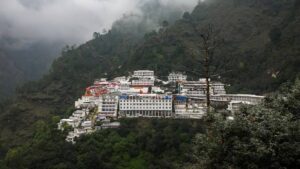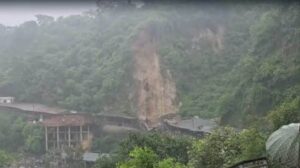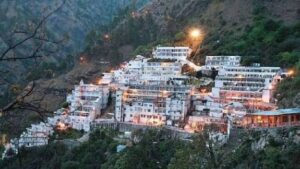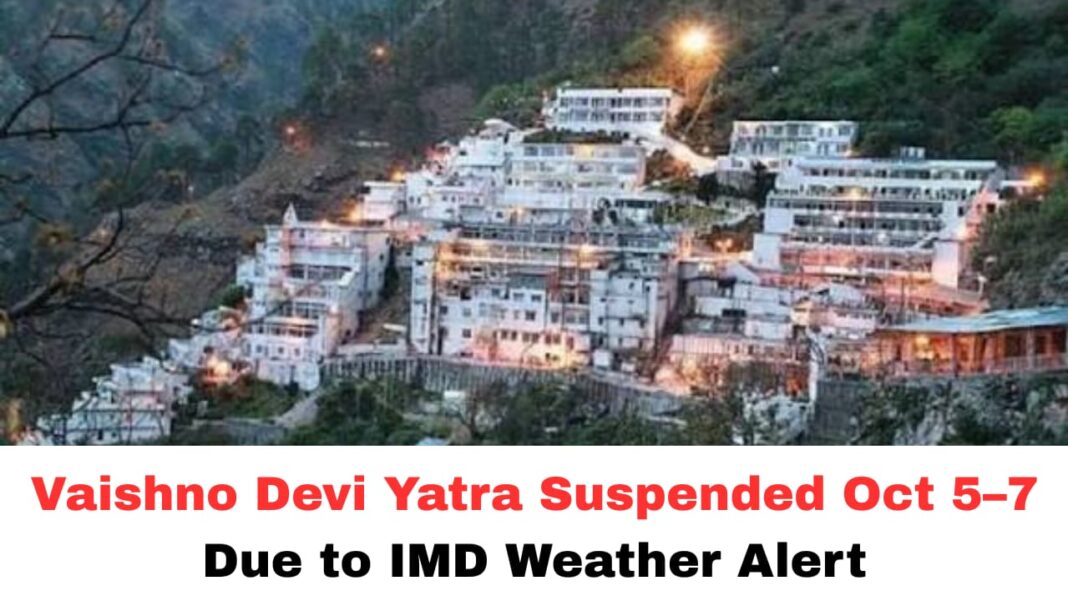Digital News Guru Jammu & Kashmir Desk:
Vaishno Devi Yatra Suspended from October 5 to 7 Amid Severe Weather Warning
In a precautionary move prompted by inclement weather forecasts, the Shri Mata Vaishno Devi Shrine Board has announced that the Vaishno Devi Yatra will be suspended for three days — from October 5 to October 7, 2025. The pilgrimage is expected to resume on October 8, conditions permitting.
Reason for Suspension: Weather Warnings and Risk Factors
The decision follows an advisory from the India Meteorological Department (IMD) that forewarns of heavy to very heavy rainfall in various parts of Jammu & Kashmir during the period. The IMD predicts that a western disturbance will influence the region, bringing widespread rains and even snow in higher reaches, with peak activity expected between the night of October 5 and morning of October 7.

Given the terrain, the Shrine Board and authorities fear that the weather may trigger landslides, flooding, cloudbursts, and general track instability — posing serious threats to the safety of devotees on the pilgrimage route. Accordingly, the suspension is deemed a precautionary measure.
In its public advisory, the Shrine Board cautioned devotees against traveling to Katra, the base camp for the Vaishno Devi route, during the suspension period. Devotees have also been asked to monitor updates through official channels for confirmation of resumption.
Historical Context: Past Disruptions and Risks
It is not the first time that the Vaishno Devi Yatra has faced suspension due to extreme weather. Earlier in 2025, the pilgrimage was halted for 22 days in August following a catastrophic landslide, which resulted in the deaths of some 34 people, many of them pilgrims, near the Adhkunwari section of the route. That suspension lasted until mid-September.
In that earlier incident, the landslide struck near the rest house area (Bhojnalaya) at Adhkuwari, rendering sections of the path impassable and causing major disruption to the ‘new track’ route. Services like the battery cars, cable cars, and helicopters were temporarily suspended in affected segments. In the past, over 250 steps on the route have been washed away or damaged during heavy rainfall episodes.
These past incidents underscore the vulnerability of pilgrimage routes in mountainous terrain to sudden weather changes, and the extent to which the Shrine Board and local administrations must constantly monitor conditions and be ready to act.

Impact on Devotees and Local Administration
Thousands of pilgrims typically undertake the Vaishno Devi journey every day, especially during festive seasons and auspicious periods. In recent days, over 1.70 lakh (170,000+) devotees had paid obeisance at the shrine during the recent Navratri period. With the suspension in place, many who had planned travel or were en route may now need to postpone or rearrange their plans.
The local administration in Reasi district—where Katra and the shrine lie—must also reposition its logistics and resources. Tourist accommodations, transport services, security, and crowd management arrangements may need temporary adjustment. The Shrine Board and district authorities have urged pilgrims to stay updated via official announcements before starting their journey to Katra.
In Katra town itself, the suspension may dampen the usual footfall, affecting local businesses that depend on pilgrimage traffic — lodging, eateries, transport, shops catering to pilgrims, and so on. However, local authorities likely view the safety of pilgrims as the overriding priority.
Challenges and Safety Measures
Suspending a major pilgrimage is not a decision taken lightly. The Shrine Board must balance religious sentiment, devotee aspirations, and logistical constraints against the real risk to life and property. In rugged Himalayan terrain, rain events can quickly destabilize slopes, cause flash floods in streams the trail crosses, or trigger cloudbursts.
To mitigate risks, the Shrine Board and administration may undertake or accelerate the following:
- Frequent inspection of trail segments, tunnels, slope stability checks
- Clearing drainage paths and debris to prevent waterlogging and erosion
- Monitoring weather updates and issuing alerts in real time
- Deploying emergency response teams, medical aid, and rescue equipment
- Communicating clearly with pilgrims via official websites, notices, local media
- Restricting movement in particularly vulnerable zones even after resumption, until conditions stabilize
Public awareness is also crucial. Devotees should avoid attempting the trek during active rain, heed signs or barricades, carry appropriate gear, travel in groups, and follow instructions from authorized personnel.

Outlook and Precautions Post-Resumption
If weather clears by October 8, the Yatra may resume, but with caution. The Shrine Board may open the route in phases, assessing each section before allowing passage. Travelers planning the pilgrimage around those dates should stay alert to last-minute changes.
Given the uncertainty of weather in the Himalayan region, it’s advisable for prospective pilgrims to:
- Monitor IMD forecasts for Jammu & Kashmir
- Check Shrine Board announcements or the official Yatra portal
- Be prepared for alternate plans or delays
- Avoid arrival in Katra before confirmation of route status
- Follow local advisories strictly
In all, while the temporary suspension is an inconvenience for many, the prime motive is safeguarding life. In mountain pilgrimage circuits, nature’s unpredictability is always a factor, and timely interventions such as this may prevent tragedies.
You May Also Read: UN Lifts Travel Ban on Taliban FM Muttaqi — India Visit in October Possible








